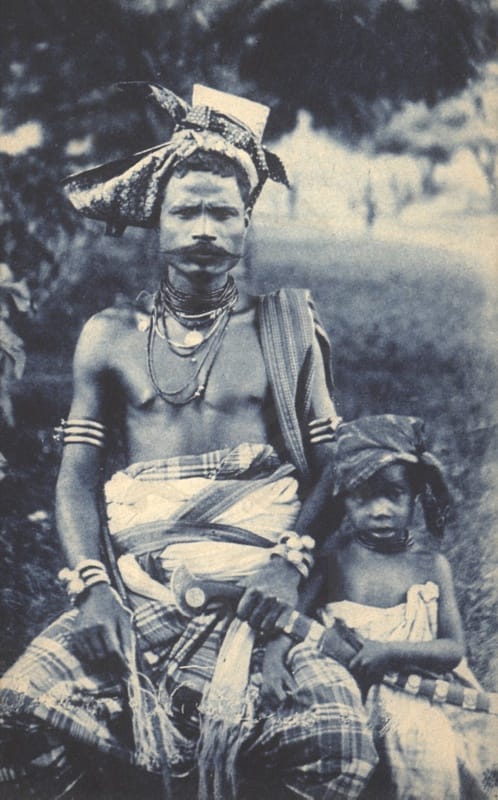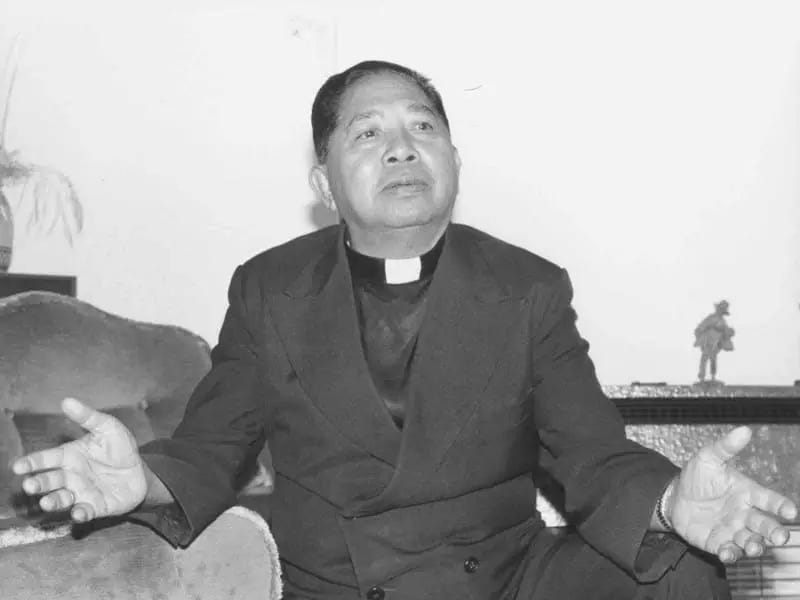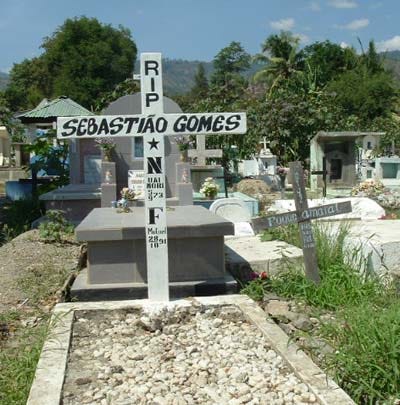The Sat Report: Timor-Leste, how the Church helped to build a nation.
One of the great success stories of the Church in Post-Conciliar era, whose image has been severely tarnished by the scourge of clerical sexual abuse
On Monday afternoon, the Holy Father departs on the 45th Apostolic Journey of his Pontificate, and his first international trip of this year, spending 10 days visiting Indonesia, Papua New Guinea, Timor-Leste and Singapore. This week on the Sat Report we profile Timor-Leste, second only to the Vatican City State, as the most Catholic country in the world, where Pope Francis will spend just under 48 hours, in a packed schedule that includes a visit to school for children with special needs, meeting with the religious of the country, a private meeting with the Society of Jesus, assisting Mass and a meeting with young people.
Yesterday, marked the 25th Anniversary of the referendum that restored Timor-Leste’s independence. After suffering decades long, brutal, violent and bloody occupation by Indonesia, the people of Timor-Leste finally had their future in their own hands. However, as soon as the sun set that day, a quarter of century ago, the people of East Timor would face a bloody retaliation by militias backed by the Indonesian government. The country was left more destroyed than it had been after the invasion of the Japanese during World War II.
The number of people that came out to vote that day surprised everyone, even the UN, who thought the threat of violence by pro-Indonesia militias would suppress turnout. One Timorese, Marcelo Caetano, speaking about that day said, “The human being is afraid, but God gives you the courage to take opportunities especially when time is short.” Jamsheed Marker, a UN observer, remarking on the turnout said on that day “It tells you about the desire for freedom that exist in everybody”
Xanana Gusmão, a Jesuit educated political leader of the resistance movement to the Indonesian occupation, who was imprisoned in Jakarta was given temporary release to vote in the referendum. He would later go on to be the first president of an independent Timor-Leste and is the current Prime Minister. José Ramos-Horta, the Foreign-minister-in-exile, current President, famously voted in the town of Liverpool, New South Wales, Australia.
The optimism of the day, disappeared with the shadows of night, as news of an imminent defeat for the pro-Indonesia lobby, saw the arrival of Indonesian troops and Indonesia backed militiamen, that unleashed days of brutal violence on the streets of East Timor. In the dead of night, whole families would head into the forested mountains to escape the sound of bullets.
Days later, in what would be a surprise to no one, Kofi Anan, the then Secretary-General of the UN, announced the scale of the victory in the referendum, 78.5% of the Timorese population had voted for independence. The violence intensified, especially in urban areas. Two thousand people, crawling through barbed wire, took refuge in the UN headquarters in the capital, Dili.
People were massacred in the streets. Dom Ximenes Belo, the Apostolic Administrator of Dili, would speak out against the violence saying in a press conference; “What we are witnessing is a genocide, a clearing of whole village, the wiping out of all inhabitants.”
The situation was becoming extremely dangerous and international journalists were being forced to flee, but it was too late for the Indonesian government to try to hide what was happening. At the UN, António Guterres, the then Prime Minister of Portugal, and now the current General-Secretary of the United Nations, would plead for Indonesia to withdraw from the territory, and allow an international peace-seeking task force to enter. Coincidently, Guterres was made a Timorese citizen yesterday during the commemorations of the 25th Anniversary of the independence referendum.
The Indonesian government initially refused to withdraw, but eventually did so after US President Bill Clinton threatened to withdraw American financial and military aid from Indonesia. Australian troops, who were for decades allies of the Indonesian government on the issue of East Timor self-determination, were the first to land on the island as a taskforce for peace. What they found was horrific. Ruins, corpses, and mass graves. What they did not find were many guerrillas, the very people who committed these atrocities, who like the cowards they were, escaped into Indonesia controlled West Timor.
Independence was finally achieved on May 20, 2002. It would take till about 2009, for the country, now self-determining, to rebuild the infrastructure, civic buildings, and the schools left in tatters by the actions of Indonesia following the referendum. It was in the blood spilt in that September of 1999, that birthed a nation, Timor-Leste.
The Arrival of the Portuguese and the Catholic Faith
What is almost unique about Timor, that unlike other the islands that would later become the country of Indonesia, Islam was never able to gain any sort of hold in the island of Timor. When the Portuguese arrived on the island of Timor, on the Feast of the Assumption, 1515, they discovered a local population clinging to animist religious beliefs.
In 1562, Jorge de Santa Luzia, the Bishop of Malacca sent the first missionaries, Dominicans, to the island, which had hitherto been merely a trading outpost in the wider Portuguese spice trade routes. The Order of Preachers would maintain a presence on the island until their expulsion in 1834, during the dissolution of the monasteries throughout the Portuguese Empire, following the Liberal Revolution.
Along with the Dominicans, Jesuits would also play a significant role in the development of the territory, primarily through building of schools and in defending the indigenous population from potential exploitation by both Portuguese colonial rulers and Dutch invaders. They did this by enculturating themselves with the local chiefs and nobility. This would be the status quo of the Church in Timor for the next 400 years, not really making much headway in terms of conversions, but generating much goodwill with the indigenous population.
The 20th Century
East Timor was the only Portuguese territory to see action during World War II, with an invasion by Japan in 1942. East Timor suffered badly at the hands of Japanese troops. Timor, like many of the islands of the Dutch East Indies were razed to the ground by Japanese troops. The situation in Timor was complicated by the Colunas Negras, groups of Timorese militiamen who worked with the Japanese to terrorize the civilian population. During the war, it is estimated that Japan killed an estimated 70,000 Timorese civilians.
I mention World War II, only to speak about a Portuguese national hero, and Catholic convert, Aleixo Corte-Real. A local chief, who as a young man fought with the Portuguese against Dutch incursion into East Timor in 1912. He would be baptised by Jesuits in 1931, at the age of 45, and his entire village followed. His faith would remain important to him for the rest of life, having a strong devotion to the Five Holy Wounds of Christ, after having told the story of how they had come to have been represent of the flag of Portugal by the Jesuit missionaries. In 1943, his village was surrounded by Japanese and Colunas Negras troops, and Dom Aleixo fought valiantly until his ammunition ran out. He was captured and shot dead after he refused to trample on the Portuguese flag. Dom Aleixo remains a pivotally and legendary figure for the national psyche of Timor-Leste, an example of the indominable spirit of the nation, formed by the Portuguese and by the Catholic Church.
Fall of the Estado Novo and Invasion by Indonesia
After the Carnation Revolution, Indonesia invaded East Timor in December 1975. At the time, Catholics would make up less than 25% of the population. In a way Timor-Leste is one of the great success stories of Vatican II, due to the work the Church did for Timorese self-determination, the blood split by the people for independence, and re-orientation of the local Church to needs of the indigenous population, that would see the country become 97.8% Catholic, numbers nowhere near reached even after centuries of Portuguese missionary activity. As an aside, this is why I feel the Church in Africa was such a success following Vatican, it adapted to the needs of the indigenous population became in incultured there, where the opposite happened in Europe, the Church failed to adapt to the needs of the indigenous population, discarded centuries of inculturation in her Liturgy, and poured scorn on the popular piety of ordinary Europeans. More on that in a future Sat Report.
The Indonesian occupation would see the most horrific of crimes, from routine and systematic torture, sexual slavery, massacres, and deliberate mass starvation. And through it all the Church remained faithful to indigenous people, even though many of them were not Catholic, because the Church has always been a light on hill, a safe harbor to protect all who seek refuge in her from evil.
At the time of the invasion, the Portuguese-born, José Joaquim Ribeiro was the Bishop of Dili, at the time the only Diocese in the country. He and his Vicar-General, the Timor-born Martinho da Costa Lopes, were vocal opponents of the invasion. Ribeiro would suffer a mental breakdown, and feeling that in the post-colonial, post-Vatican II era, there was no place for European bishops in the global south, tendered his resignation to the Pope. Paul VI accepted his resignation at 58.
Martinho da Costa Lopes succeeded him, being named Apostolic Administrator of Dili. However, he was never consecrated as a bishop. Lopes would continue his critique of human rights violations perpetrated by the Indonesian government in the East Timor, and openly criticized military aid Indonesia was receiving from the United States that was being used to kill civilians in Timor.
In 1981, the local language of Tetum replaced Portuguese as the official language of the Liturgy in the country, its translation of the Roman Missal, incidentally, is much more faithful to the original Latin, than the Portuguese is till this day. 1981 also saw the massacre of 500 Catholics, mostly women and children by the Indonesian army at the Shrine of St. Anthony of Lisbon, in the village of Lacluta. Lopes called the violence a Muslim genocide against the growing Catholic population of East Timor. He was successful in publicly exposing the actions of the Indonesian government. He famously said, “I feel the irrepressible need to tell the whole world about the genocide being practiced in Timor so that, when we die, at least the world will know we died standing.”
Indonesia with the help of Australian Prime Minister Gough Whitlam successfully lobbied the Vatican in 1983 to removed Lopes from his post as Apostolic Administrator of Dili, on the pretences that he was destabilizing the island by inciting nationalist sentiment. Lopes was summoned to Rome on May 17, 1983, to meet with John Paul II. Prior to this meeting, Agostino Cardinal Casaroli, Secretary of State of the Holy See, and Agnelo Cardinal Rossi, Prefect of the Congregation for the Evangelization of Peoples, advised Lopes to submit his resignation to the Pope. He did so and left for Portugal, never to return to East Timor.
He was replaced as Apostolic Administrator of Dili by Carlos Filipe Ximenes Belo, a Timorese Salesian, who was seen by Rome as less combative and more amenable to the disastrous Ostpolitik policies of Casaroli. This proved not to be the case. Within months of taking office, the Indonesian Army committed a series of mass killings, which would become to be known as the Kraras massacres, where Catholic men were killed, as their wives and daughters were raped. The region of Kraras would from that day forward be known as the ‘Valley of Widows’.
In 1986, Ximenes Belo would be consecrated as the Titular Bishop of Lorium, but not the Bishop of Dili, despite remaining the Apostolic Administrator, as per Vatican Ostpolitik policy. Ximenes Belo would later remark “I replaced the popular Monsignor Martinho da Costa Lopes who, after condemning the atrocities committed by the Indonesians, was urged by the Vatican to resign following pressure from the Indonesians.”
Ximenes Belo would use his position to secretly lobby Portugal, the Holy See and the UN to sponsor a referendum on the independence of East Timor. This would be become public in April 1991, when the UN announced a delegation would visit the territory, investigate the atrocities, and look at the viability of a referendum, further antagonizing the Indonesian government, whose brutal oppression of Timor would culminate in the November 12, 1991, Santa Cruz Massacre.
The Massacre was captured on film by British journalist, Max Stahl, occurred in a Catholic cemetery in Dili, when during a funeral procession for a pro-independence activist, Indonesian troops opened fire on the faithful present, killing at least 250 people. The massacre drew significant international attention and condemnation, putting the severe human rights abuses occurring in East Timor on the television screens of millions of people throughout the world, and was the turning point that would eventually lead to the independence of Timor-Leste.
Clerical Sexual Abuse and the fall of an independence icon
As one of the most prominent Church figures in the liberation movement of Timor-Leste Ximenes Belo, who along with José Ramos-Horta, the current President, would win the Nobel Pease Prize in 1996 for their work "towards a just and peaceful solution to the conflict in East Timor."
Ximenes Belo was conspicuous by his absence at the events marking this year’s anniversary of the independence referendum. His current whereabouts are not known. He is not allowed to return to Timor-Leste due to sanctions imposed on him by Pope Francis.
Dom Ximenes Belo resigned as Apostolic Administrator of Dili on November 22, 2002, at the age of 58, at the time an icon of East Timor’s liberation movement and a Nobel Prize winner. Unlike his predecessor, he wasn’t forced out of Office by the Vatican, and although no official reason was ever given, it was assumed to have been for health reasons, given that soon after Ximenes Belo resigned he would undergo cancer treatment in Lisbon. With the blessing of the Salesians, he would return to active ministry in 2004, working as an assistant Parish Priest in Mozambique, focusing on the pastoral work with the children and young people of the parish. He would never return to East Timor.
On 28 September 2022, De Groene Amsterdammer, an independent Dutch magazine, published a report detailing the experiences of two men, who claim that they had been sexually abused by Ximenes Belo as children, as were hundreds of other boys both prior to and after his appointment as Apostolic Administrator of Dili. The Vatican to its credit responded quickly to the allegations of De Groene Amsterdammer, confirming that secret sanctions had been imposed on Ximenes Belo in 2020, after the Vatican had investigated allegations that it had received the previous year. These included restrictions on Ximenes Belo's movements and the prohibition of him from having any contact with children. The Vatican acted swiftly in imposing these sanctions, but the fact that were secret raises many obvious questions.
Any sanctions imposed on bishops because of the sexual abuse of minors should not be secret. These sanctions should not be secret. This is obvious, secret sanctions are impossible to enforce, and as a result they do nothing to protect minors. Why Pope Francis thought it was a good idea to do so in this case, as well as in the case of Bishop Michel Santier of Créteil, France, beggars belief. This is after the McCarrick scandal, after the much-hailed Vatican Summit on sexual abuse, and it raises the important question of how many more bishops are there who are currently under secret sanctions imposed by the Vatican as a result sexually abusing minors. I only hope and pray that someone directly asks the Pope this question on his return journey to Rome on September 13th.
Pope Francis and Timor-Leste
On August 15, 2015, the 500th Anniversary of the Evangelization of the island, the Holy See and Timor-Leste established diplomatic relations. Marking the occasion the then Prime Minister, Rui Maria de Araújo remarked “East Timor is one of the most Catholic countries in the world,” adding that Catholicism and the Portuguese language “are the two elements that have shaped our identity as a nation, and that is a good thing.” In an official statement marking the concordat the government of Timor-Leste said that the Catholic Church had for 500 years provided “great spiritual, human and material support to the Timorese people, and has contributed decisively to the liberation process of Timor-Leste.”
Timor-Leste still has its problems. In 22 years of independence, the government has mismanaged finances derived from its oil reserves, hundreds of millions of dollars wasted with almost nothing to show for it. The government has been open about its failings. What remains strong though, is the Catholic faith in the country, but the Church has been rocked by the revelations that one liberation hero Dom Ximenes Belo has a sexual deviant who preyed on young boys. The Pope will find a healthy Church, but one that has been wounded, like so many others, by the scourge of clerical abuse. The legacy of his trip to Timor-Leste will hinge on how he confronts this and the Vatican’s own actions and inactions with regards to one of the Timor-Leste’s most famous sons.






